I convinced the bosses (not hard to do really) to let me build a cold frame at work as a sort of show bed. I told them I could convince people more easily to use our topsoil if they can see a pleasant little crop of radishes, beets, and greens. Besides, with what we promote and believe as a company, how can we NOT have a vegetable garden?! (Actually, we tried several years ago. We did it differently and got hammered by the rabbits, the wind and the sun.)
So I did build one. It really is very simple, it only took me a morning to do it all.
As always, I start at the trusty recycled lumber pile. Between what's available and what I have in mind, I can collect the necessary pieces.

Then, I construct the bed and place it. In this case, it is on a south facing wall. It will get plenty of shade from a beautiful Chitalpa in the summer, but when the tree drops its leaves, the bed will get a heavy dose of winter sun. Hopefully the building will trap some heat and protect the cold frame from some wind. Maybe we will even get a little heat from the radiant heater that sits inside the office.

Before I fill the frame with a high quality planting medium (read: Soilutions' Topsoil Blend; a mixture of our Premium Compost and local sandy loam that is approved for use on certified organic gardens in NM) I placed a wire mesh on the bottom. My intent is to keep squirrels, skunks, or gophers out of it. I used a piece of galvanized hardware cloth that we had sitting around the heap. Chicken wire would work well, too.

In goes the Topsoil Blend...

then the seeds.

I scavenged a couple of lengths of 3/4" PVC and some sheeting from our trash pile and put together a little hoop frame to cover the bed. This will act like a greenhouse: keep the moisture and the day's heat in and the frost out. 1/2" PVC would have worked better, i.e., more flexible, but when you using recycled materials, you take what you find.

If, during the day, it gets too warm, which is all too often this time of year, I can open the lid temporarily.

Stay tuned for progressive photos of the sprouts. Don't be bashful, come on down and grab a radish or two!









